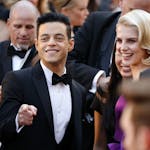Pictures of Longing: Photography and the Norwegian-American Migration
By Sigrid Lien, translated by Barbara Sjoholm. (University of Minnesota Press, 304 pages, $29.95.)
Descendants of Norwegian immigrants know of the albums stowed somewhere holding old family photos from those earliest days of settlement. The solemn and still faces reveal family resemblances. Their settings fill in a few cracks of family lore. But mostly, they are soon shelved once again. In that way, "Pictures of Longing" seems familiar, but it's so much more.
Lien has assembled a collection of more than 250 remarkable photos taken mostly by fellow Norwegians who took up photography as a New World profession. There are the common family portraits, but there are also candid street scenes, "action" shots (in their own way) of workers, a minister reading wedding vows, a grieving couple with their infant's casket.
Lien, a professor of art history and photography studies at the University of Bergen in Norway, dissects these photos to reveal details that make them far more informative than they first appear. Some are "brag" photos meant to reassure — or lure — those still in Norway. She goes deep into collections by certain photographers such as Gilbert Ellestad, who documented early Lanesboro, Minn. She also highlights a surprising number of female immigrants who became photographers, born by the enterprising spirit of America.
One nit: Lien can at times seem to labor over finding meaning in each element in a photo. Was the ball of wool included to send a larger message — or is it simply a ball of wool? Sometimes, she provides the thousand words that the photo is meant to convey (ably translated by Barbara Sjoholm). But overall, her scholarship is keen and illuminating, as is her reverence and joy in the subject. Put this book on an easily reached shelf.
KIM ODE
When Brooklyn Was Queer
By Hugh Ryan. (St. Martin's Press, 308 pages, $29.99.)
One of the best things about Ryan's history of LGBTQI Brooklyn is that he knows what he doesn't know. That may sound like faint praise, but it isn't. So many histories overlook huge parts of gay life — women, people of color — but Ryan makes sure they're part of his narrative. When the information isn't available — which is often, with laws and social mores forcing gay communities to remain invisible — Ryan admits it. As a result of the sketchy records left behind by people who feared for their lives, the early years of the 1855-1969 period he covers in "When Brooklyn Was Queer" are the trickiest for Ryan, who nevertheless uses diaries, poetry and newspaper accounts to give a sense of 19th-century gay Brooklyn.
The author writes admiringly of another book about gay life that is "scholarly but readable," and the same could be said for his book, which is at its best when he has the material to make people and scenes vivid. For instance, Ryan writes sensitively of poet Marianne Moore, who was probably asexual but nurtured the talents of dozens of queer artists.
And who knew that the years of World War II, with large numbers of straight men overseas, saw a flowering of queerness in America? Or that one house in Brooklyn was practically the center of the gay world in 1940, when it was home to writers Carson McCullers and W.H. Auden, as well as performer Gypsy Rose Lee and composer Benjamin Britten, all of whom hosted dinner parties that included Aaron Copland, Leonard Bernstein and Paul Bowles?
CHRIS HEWITT






